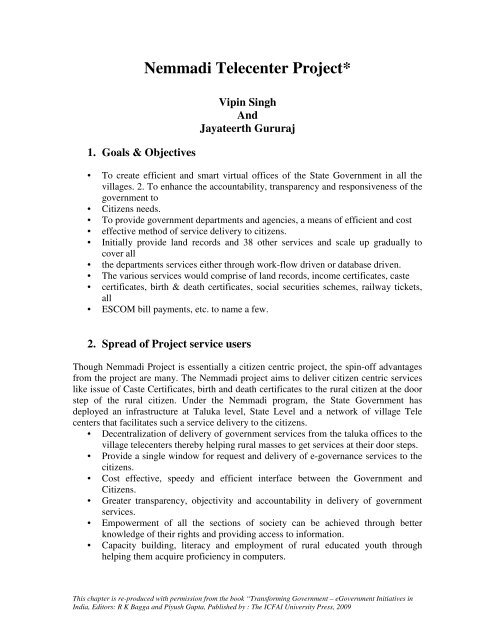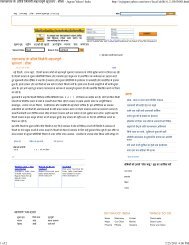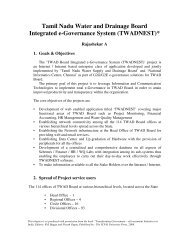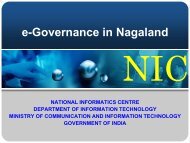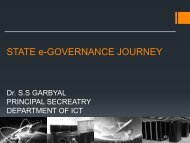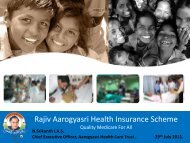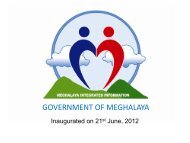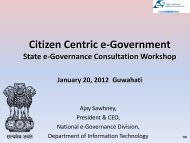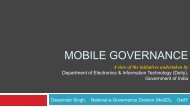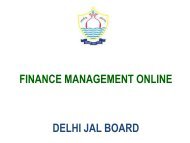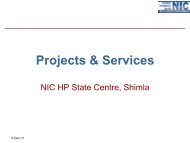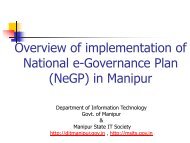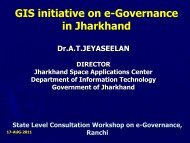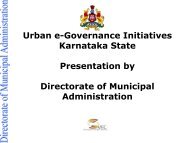Nemmadi Telecenter Project* - eGovReach
Nemmadi Telecenter Project* - eGovReach
Nemmadi Telecenter Project* - eGovReach
You also want an ePaper? Increase the reach of your titles
YUMPU automatically turns print PDFs into web optimized ePapers that Google loves.
1. Goals & Objectives<br />
<strong>Nemmadi</strong> <strong>Telecenter</strong> <strong>Project*</strong><br />
Vipin Singh<br />
And<br />
Jayateerth Gururaj<br />
• To create efficient and smart virtual offices of the State Government in all the<br />
villages. 2. To enhance the accountability, transparency and responsiveness of the<br />
government to<br />
• Citizens needs.<br />
• To provide government departments and agencies, a means of efficient and cost<br />
• effective method of service delivery to citizens.<br />
• Initially provide land records and 38 other services and scale up gradually to<br />
cover all<br />
• the departments services either through work-flow driven or database driven.<br />
• The various services would comprise of land records, income certificates, caste<br />
• certificates, birth & death certificates, social securities schemes, railway tickets,<br />
all<br />
• ESCOM bill payments, etc. to name a few.<br />
2. Spread of Project service users<br />
Though <strong>Nemmadi</strong> Project is essentially a citizen centric project, the spin-off advantages<br />
from the project are many. The <strong>Nemmadi</strong> project aims to deliver citizen centric services<br />
like issue of Caste Certificates, birth and death certificates to the rural citizen at the door<br />
step of the rural citizen. Under the <strong>Nemmadi</strong> program, the State Government has<br />
deployed an infrastructure at Taluka level, State Level and a network of village Tele<br />
centers that facilitates such a service delivery to the citizens.<br />
• Decentralization of delivery of government services from the taluka offices to the<br />
village telecenters thereby helping rural masses to get services at their door steps.<br />
• Provide a single window for request and delivery of e-governance services to the<br />
citizens.<br />
• Cost effective, speedy and efficient interface between the Government and<br />
Citizens.<br />
• Greater transparency, objectivity and accountability in delivery of government<br />
services.<br />
• Empowerment of all the sections of society can be achieved through better<br />
knowledge of their rights and providing access to information.<br />
• Capacity building, literacy and employment of rural educated youth through<br />
helping them acquire proficiency in computers.<br />
This chapter is re-produced with permission from the book “Transforming Government – eGovernment Initiatives in<br />
India, Editors: R K Bagga and Piyush Gupta, Published by : The ICFAI University Press, 2009
3. Services provided<br />
The State Government adopted a gradual approach to ensure success of the program.<br />
Initially only RTC (land records) were given from the <strong>Telecenter</strong>s and number of services<br />
were increased to 38. It identified two critical parameters; firstly requirement of a robust<br />
application and secondly, a network of delivery centers for delivery of the services to the<br />
citizens Prior to the rollout of the program in the entire State, the government piloted the<br />
program in one taluka for a period of one year. During this pilot, both the software and<br />
service delivery parameters were refined and the pilot expanded to 11 talukas in Mandya,<br />
Davanagere, Dharwad and Bangalore Urban districts. The learning’s from the pilot were<br />
incorporated in the rollout of the program in the entire state. Presently the services are<br />
workflow driven except land records which are database driven. However on the second<br />
and subsequent requests for same service, the certificate is delivered across the counter<br />
from the database created incrementally. The certificate is digitally signed at the back<br />
office, obviating the need for a government official to be present at the telecenters for<br />
signing the certificates printed at the telecenters. An effort is being made to digitize caste<br />
data and Birth and Death data, which once done, will help us to deliver most of the<br />
services online. The lists of services which are being offered through the telecenters are<br />
as follows:<br />
List of RDS services<br />
S.No. Services Individual<br />
1 Birth Certificate (Registered in current year Jan-Dec)<br />
2 Birth Certificate (Registered in previous years)<br />
3 Death Certificate (Registered in Current year Jan-Dec)<br />
4 Death Certificate (Registered in previous years)<br />
5 Census Certificate<br />
6 OBC Certificate for GOI Jobs<br />
7 Caste Certificate for Category-A<br />
8 Caste Certificate for other Categories<br />
9 Caste Certificate for SC/ST<br />
10 Residence Certificate<br />
11 Income Certificate<br />
12 No tenancy Certificate<br />
13 Addition of Name in Ration Card<br />
14 Deletion of Name in Ration Card<br />
15 Widow Certificates<br />
16 Living Certificate<br />
17 Agri Family members Certificate<br />
18 Re-marriage Certificate<br />
19 Land less Certificate<br />
20 Surviving Family Member Certificate<br />
21 Income certificate for compassionate appointment<br />
22 Endorsement for non availability of Birth/Death Certificate<br />
23 Unemployment Certificate<br />
This chapter is re-produced with permission from the book “Transforming Government – eGovernment Initiatives in<br />
India, Editors: R K Bagga and Piyush Gupta, Published by : The ICFAI University Press, 2009
24 No government job certificate for Compassionate appointments<br />
25 Agriculturist Certificate<br />
26 Small & Marginal Former Certificate<br />
27 Agri Labour Certificate<br />
28 Non-creamy layer Certificate (For education) Registration of Birth and Death<br />
29 Birth registrations within 21 days<br />
30 Birth registrations within one year<br />
31 Birth registrations beyond one year<br />
32 Death registrations within 21 days<br />
33 Death registrations within one year<br />
34 Death registrations beyond one year Social Security Schemes<br />
35 Old Age Pension<br />
36 Widow Pensions<br />
37 Physically handicapped pension Utility Bill Payment<br />
38 BESCOM Bill payments<br />
39 Telephone Bill Payments<br />
40 IRCTC Booking<br />
4. Geographical spread of project implementation<br />
Karnataka’s geographical (revenue) set up is as follows: State has 27 districts and 177<br />
taluks, 749 Hoblis. The <strong>Nemmadi</strong> telecenters have been established in each of 749 Hobli<br />
Head quarters. This apart, some of the Hoblis have been provided with additional<br />
telecenters to cater to citizens needs. There will be a maximum of 800 such telecenters<br />
across rural areas of Karnataka. Apart from these <strong>Telecenter</strong>s, each Taluka office has a<br />
Back office which enables delivery of e-Governance services which are work flow<br />
driven. So a citizen who had to visit a Taluka office to avail such services which are<br />
being offered in <strong>Nemmadi</strong>, by traveling on an average 30 km, will visit nearby Hobli<br />
<strong>Telecenter</strong> to get same services which are just 5 km away. The citizen would get all the<br />
38 services which were given earlier in Taluka offices, right from <strong>Telecenter</strong>s. The<br />
citizen would also get other B2C services as well.<br />
5. Project Timelines and milestones<br />
The e-Governance department (Government of Karnataka) adopted a step by step<br />
approach to ensure delivery of 38 different services of the program as per the objectives.<br />
The other challenge is to ensure that there is no negative publicity due to initial<br />
technological problems. The project team identified important factors such as<br />
requirement of a robust application and a network of delivery centers for delivery of the<br />
services to the citizens. The application incorporated the following parameters<br />
a. Adopting the process of delivery of services at the Government offices, thus a work<br />
flow process has been adopted in the <strong>Nemmadi</strong> Software which merges both paper and<br />
electronic work flow<br />
b. It was understood that robust “always on” connectivity would not be available hence<br />
local queuing, store and forward technology using MSMQ and MSDE was adopted in the<br />
This chapter is re-produced with permission from the book “Transforming Government – eGovernment Initiatives in<br />
India, Editors: R K Bagga and Piyush Gupta, Published by : The ICFAI University Press, 2009
Village Tele centre. Prior to roll out of the program in the entire State, the government<br />
piloted the program in one taluka for a period of one year. During this pilot, both the<br />
software and service delivery parameters were refined and the pilot expanded to 11<br />
talukas of Mandya, Davanagere, and Dharwad and Bangalore Urban districts. The<br />
learning’s from the pilot were incorporated in the rollout of the program in the entire<br />
state. Apart from physical inspection by the project team, the other feedback mechanism<br />
is its MIS reports. The online MIS reports give telecenter wise day to day transaction in<br />
detail as well as monitor the uptime and attendance of the operators. Since an application<br />
has to go through six stages before a certificate is generated, pendency reports can be<br />
generated at each level. This report can be accessed by all the stake holders such as<br />
<strong>Telecenter</strong>s, Back offices, district as well as taluka administration etc. and corrective<br />
action is taken immediately. All the certificates were signed digitally as per IT Rules<br />
2000 and for which physical signature is not required. Karnataka IT Rules have been<br />
framed for providing a legal framework.<br />
6. Direct cost and time savings to avail services<br />
A citizen who had to spend a whole day and a minimum of Rs.150/- to get services by<br />
way of travel cost and other miscellaneous expenditure, will have to pay just Rs.15/- as<br />
service fee to the <strong>Telecenter</strong> Operator to avail same services which were issued manually<br />
earlier. Since all the services are finally delivered from the <strong>Telecenter</strong> itself, a citizen<br />
need not travel to taluka office at all. And hence the citizens are stopped from getting<br />
harassed by middlemen and other persons at taluka office.<br />
In manual system, though all the services were provided free of cost to the citizens, they<br />
were supposed to come to Taluk office or district headquarters for services thereby<br />
spending at least 2 hours in traveling to and fro from his village. As the delivery of these<br />
services were person dependent, the time a citizen spends in taluka or district<br />
headquarters is nothing less than 3 hours, before he gets the required service. In other<br />
terms a farmer/citizen had to spend an entire day for Government services. But now 769<br />
<strong>Telecenter</strong>s have been established all the Hobli head quarters, a citizen will not travel<br />
more than 5-10 Km to avail services. Since these <strong>Telecenter</strong>s are located outside<br />
Government offices, a citizen is not at the mercy of officials and moreover services are<br />
delivered on line, citizen will not spend more than 5 minutes at the <strong>Telecenter</strong>s.<br />
7. Direct cost and time savings to deliver services<br />
In manual system, all the services were delivered to citizens free of cost except in case of<br />
Birth and Death Certificates which was again very nominal. The indirect cost incurred by<br />
the government in earlier system were, field verification by concerned authorities<br />
authenticate the Applicant’s claims and stationery used to create Office note and<br />
Certificates. In the present system, entire data has been digitized and have been verified<br />
and vetted by concerned officials. Since the certificates are given online (from the<br />
database) to citizens, there is no need for verification by the officials once again there by<br />
cost saving for the government indirectly.<br />
This chapter is re-produced with permission from the book “Transforming Government – eGovernment Initiatives in<br />
India, Editors: R K Bagga and Piyush Gupta, Published by : The ICFAI University Press, 2009
Though the Village Accountants and Revenue Inspectors had different and varied<br />
responsibilities, most of their time was spent in issuing various services. This had<br />
affected the administration as they were not getting enough time to look at developmental<br />
activities. So much so, in many cases the certificates were issued even without any field<br />
verification of the data by the concerned officials. In <strong>Nemmadi</strong> Project, objective is to<br />
give most of the services on line through the database thereby reducing human<br />
intervention. Once the digitized data is verified by Village Accountants and Revenue<br />
Inspectors, they have no role to play in delivery of the certificates.<br />
8. Replication<br />
<strong>Nemmadi</strong> project is one of its kinds wherein services are delivered online from 769<br />
virtual government offices (<strong>Telecenter</strong>s). Many such initiatives in the past have failed for<br />
the lack of support from Government for such PPP projects. <strong>Nemmadi</strong> Project as such<br />
stands out for the successful PPP Project.<br />
9. Implementation model<br />
While the Bhoomi program tremendously benefited the farmers there was a demand for<br />
establishing delivery centers for land records at the village level itself. The need for<br />
decentralization of Bhoomi catalyzed the development of the “<strong>Nemmadi</strong>” program of the<br />
Government of Karnataka. The objective of <strong>Nemmadi</strong> is that IT enabled government<br />
services should be accessible to the common man in his village through efficient,<br />
transparent, reliable and affordable means In the period from May 2004 to September<br />
2006 the <strong>Nemmadi</strong> model was piloted in 13 talukas of 4 districts of the state and services<br />
were delivered to the citizens through about 70 village telecentres. The experience of the<br />
pilot helped in understanding the various issues in scaling the program in the entire state.<br />
The State Government understood that it could not establish and operate computer<br />
centers at every village and hence decided to establish these centers in the villages under<br />
a Public Private Partnership model. It was also apparent that a telecenter in a village<br />
would be a single channel of delivery of various government services to the rural citizens<br />
and act as a virtual government office. In September 2006, the project was awarded to the<br />
private partner through a transparent tendering process and by April 2007 about 769<br />
telecentres were established in entire state.<br />
10. Technologies<br />
For delivery of the current set of e-Governance services comprising of Bhoomi (delivery<br />
of land records) and RDS, GoK follows a mixed architecture, i.e. the service is available<br />
both at the Taluka office ( where they have been traditionally available) and a network of<br />
village telecentres. This mixed architecture also adds to the complexity of deployment.<br />
The e-Governance service delivery infrastructure comprises of the following components<br />
• State Data Centre,<br />
• b) VSAT Network connecting each of the telecenters to the state data center<br />
This chapter is re-produced with permission from the book “Transforming Government – eGovernment Initiatives in<br />
India, Editors: R K Bagga and Piyush Gupta, Published by : The ICFAI University Press, 2009
• VSAT network connecting the state data center to the <strong>Nemmadi</strong> back offices in<br />
each of the 177 talukas<br />
• c) <strong>Nemmadi</strong> telecenters<br />
• Departmental servers at the Taluka office<br />
I. State Data Centre (SDC) – Karnataka has been one of the first states to create a State<br />
Data Centre for both hosting all e-governance applications of the state and acting as a<br />
disaster recovery centre. The State data centre is the only means for delivery channels to<br />
connect to the departmental servers thereby isolating them from the various kinds of<br />
security threats that can take place if these departmental servers were directly connected<br />
to the Internet. II. VSAT Network – 203 distributed primary databases of bhoomi in the<br />
talukas replicate to the state data center every day to update the centralized bhoomi land<br />
records database at the state data center. This is accomplished through a VSAT network<br />
and an innovative customized replication mechanism due to many to one replication<br />
schema and limited bandwidth available. Each of the telecenters has a VSAT<br />
connectivity to VSAT hub and then a leased line connectivity from the hub to the state<br />
data center. This ensures an assured connectivity to the telecenters. III. Taluka Servers –<br />
The Taluka servers are both primary repository of data and additionally data updation due<br />
to many of the work flow processes for both Bhoomi and RDS services takes place at the<br />
Taluka server. While theoretically it is possible for users to connect to a central location<br />
(State Data Centre) however given the poor state of data connectivity from remote<br />
talukas of the state at the moment this is not practical. The above architecture of Taluka<br />
servers connected to the State Data centre has many advantages. Firstly the taluka servers<br />
can be remotely managed from a central location making trouble shooting, application<br />
management and deployment easy. Secondly external users can connect to the Taluka<br />
servers only through the SDC isolating the taluka servers from various security risks.<br />
Additionally the SDC also functions as a disaster recovery site for the taluka server. IV.<br />
<strong>Nemmadi</strong> Telecentres – Village telecentres are the nodes for the citizen to make requests<br />
and access various e-governance services. In most cases these village telecentres<br />
comprise of one or two computers with associated peripheral devices like printers,<br />
scanners, web cameras and they connect to the Internet through various dialup<br />
technologies. There are many challenges in establishment of village telecentres in terms<br />
of ownership of the village telecentres, operations of these telecentres, viability and<br />
service portfolio to be delivered through these village telecentres. Over the last 5 years,<br />
across the country, there has been a range of experimentation with regards to the<br />
ownership model of telecentres and it seems clear that these village telecentres can’t be<br />
owned or operated by government agencies and need to be privately owned and operated.<br />
Additionally these village telecentres need to deploy a range of both e-Governance and e-<br />
Commerce services to be financially viable. A corollary to this is that state governments<br />
need to increase the basket of e-governance services and not just deploy 1 or 2 services<br />
that can be delivered from the village telecentres so that village telecentres established by<br />
private entrepreneurs are financially viable. V. Taluka Back office – A back office at<br />
each of the taluka receives requests from the telecenters and processes it. The back office<br />
ensures each request has been field verified for correct data and generated the finl<br />
certificate which is digitally signed by the Tahsildar through his smart card. The<br />
certificates once signed queue up electronically at the telecenter for printing and delivery<br />
This chapter is re-produced with permission from the book “Transforming Government – eGovernment Initiatives in<br />
India, Editors: R K Bagga and Piyush Gupta, Published by : The ICFAI University Press, 2009
to the citizen. It is shortly planned to introduce biometric authentication and principle of<br />
FIFO in back office operations.<br />
11. Capacity building<br />
Entire project is driven by Directorate of Electronic Delivery of Citizen Services as per<br />
the address mentioned below Director, Directorate of Electronic Delivery of Citizen<br />
Services Room No. 110, Gate No.2, Ist Floor, MS Building, Dr.Ambedkar Veedhi,<br />
Bangalore-560 001. E-Mail:director-b1@karnataka.gov.in Fax: 080-22259109 Phones:<br />
080-22370281, 080-22370282, 080-22032645 The Directorate of EDCS works under<br />
supervision of e-Governance Secretariat Details of team for the nominated project:<br />
Sri.B.L. Sridhar Pr. Secretary, e-Governance, Government of Karnataka<br />
Sri.Vipin Singh, Director, Electronic Delivery of Citizen Services, Government of<br />
Karnataka<br />
Before the start of delivery of services to citizens it was made mandatory for every stake<br />
holder to go through training program. E-Governance Secretariat organized not only<br />
training program both at district level as well as state level, but also organized Video<br />
conference at Taluka level for proper implementation of the project.<br />
12. Process Reforms<br />
The village Telelcenter will adhere to the following security techniques.<br />
• <strong>Nemmadi</strong> Application: Application supports offline mode operation for some of<br />
the RDS (Revenue department’s services) services. However a limit has been<br />
placed on the number of offline transactions to minimize the impact of data loss<br />
due to machine crash. b) Admin Access: An Operator at Village level does not<br />
have administration privileges on the machine at the telecenter. Only authorized<br />
personnel of the Agency will have administrative privileges of the telecenters.<br />
• Deployment of 3rd Party software: The testing of all the new software will be<br />
done on a test set up to see that the software is compatible with <strong>Nemmadi</strong><br />
application.<br />
• Non pirated software: There will not be any pirated software and only licensed<br />
software can be used.<br />
• Soy ware, Ad ware, malicious programs: The agency has deployed latest<br />
antivirus, anti-spy ware and firewalls in the <strong>Telecenter</strong> machines.<br />
• The agency has been given only minimal access privileges to the <strong>Nemmadi</strong><br />
databases and servers at the taluka and State Data Center which will enable him to<br />
function as per the application requirement and day to day operations. The<br />
certificates delivered at <strong>Telecenter</strong>s will not have physical signature. This has<br />
been done by making <strong>Nemmadi</strong> application PKI enabled which will enable the<br />
Operator to issue certificate at the village itself. A physical signature would<br />
require the applicant to travel to the taluka office for collecting the certificate.<br />
This was mitigated through the use of Digital Signature by the authorized officer.<br />
This chapter is re-produced with permission from the book “Transforming Government – eGovernment Initiatives in<br />
India, Editors: R K Bagga and Piyush Gupta, Published by : The ICFAI University Press, 2009
The signed hash of the electronic record is printed on the certificate as a 2D<br />
barcode. The authenticity of the document can be verified online. Besides the 2 D<br />
bar code, the certificate will be printed on a watermark stationary, a Certificate ID<br />
and a hologram to ensure its authenticity. Each Certificate also carries 2 seal<br />
impressions and the signature of the <strong>Telecenter</strong> Operator in accordance with the<br />
provisions of the IT Act 2000. To ensure the technological sustainability,<br />
following technology and application have been used in <strong>Nemmadi</strong> project.<br />
• <strong>Nemmadi</strong> application is multilingual rich client that has been developed using<br />
.Net Platform on Windows XP Professional Platform.<br />
• The architecture is N-tiered, scalable, secure and is based on the concept of<br />
Service Oriented Architecture (SOA)<br />
• <strong>Nemmadi</strong> application uses SQL Server 2000 Enterprises edition as backend in<br />
taluka server and State Data Center<br />
• In the telecenters, <strong>Nemmadi</strong> application uses MSDE (scaled down free version of<br />
SQL Server) to store master and some configured data. Such storage helps in<br />
avoiding frequent hits to database at SDC and taluka Server.<br />
• <strong>Nemmadi</strong> application supports offline functionalities and uses MSMQ support<br />
provided by Windows XP Professional to ensure durable, reliable and secure and<br />
in order delivery of data related to offline mode requests.<br />
• <strong>Telecenter</strong>s are village level connect to central hub at the State Data Center (SDC)<br />
using a dedicated VSAT connection. The SDC connects to the <strong>Nemmadi</strong> back<br />
offices at taluka office again through dedicated VSAT link. The <strong>Nemmadi</strong> back<br />
office at taluka connects to local taluka server on LAN.<br />
• RDS application uses a custom communication framework based on .Net<br />
Platform to ensure data between Taluka Server and SDC are in sync. Custom<br />
framework has been developed to encapsulate data routing.<br />
• Transaction handling, in order and reliable delivery on low bandwidth. Unlike<br />
bandwidth hungry options like RDBMS based replication or log ship<br />
communication designed for <strong>Nemmadi</strong> project uses less bandwidth and can take<br />
care of unreliable network and offline mode.<br />
13. Project Financials/Sustainability<br />
<strong>Nemmadi</strong> project has been developed on PPP basis. Entire capital recurring cost has been<br />
borne by PPP Partner. Government of Karnataka has provided 200 sq.ft spaces in each of<br />
the taluka offices for establishing back offices to support <strong>Telecenter</strong>s. The PPP partner<br />
would earn his revenue from<br />
• Share of the user charges for e-Governance services. The user charges are<br />
different for different category of services and also different for slabs of a given<br />
category of services.<br />
• A Transaction charge for bill collection for Utility Companies, Panchayat<br />
property Tax etc.<br />
• Fees from the Government of Karnataka for providing services under various<br />
Government programs like Sarva Shiksha Abhiyan.<br />
• Data entry charges for operations like Crop Updation or for digitization of data of<br />
various Government offices.<br />
This chapter is re-produced with permission from the book “Transforming Government – eGovernment Initiatives in<br />
India, Editors: R K Bagga and Piyush Gupta, Published by : The ICFAI University Press, 2009
• Hiring of hand held devices for departments of Government of Karnataka<br />
• B2C services for which the <strong>Telecenter</strong> Agency would need to work with various<br />
content and service providers.<br />
• Other IT and Internet based services like computer education, DTP work etc.<br />
Though Government of Karnataka is putting all efforts to include many government<br />
services of various departments, it is assumed that the <strong>Telecenter</strong> project cannot sustain<br />
only on Government services and hence there is a provision for the telecenter Operator to<br />
provide even B2C (Business to Citizen) services from these telecenters like following<br />
services.<br />
a. Cell phone bill payments and prepaid cell phone recharge top-ups.<br />
b. CET training.<br />
c. Insurance premium payments.<br />
d. Private bus operators’ ticket bookings.<br />
e. Computer education<br />
f. English speaking courses<br />
14. Project Teams and Leadership<br />
<strong>Nemmadi</strong> Project Team is consisted of various consultants led by Director, EDCS under<br />
direct supervision of Secretary, e-Governance.<br />
15. Key project Outcomes<br />
The project started on 1st October 2006. At present, 769 telecenters out of 800 telecenters<br />
are operational. There are two distinct types of services delivery. First, RTC (land<br />
records) which are delivered are issuing land records. 60 Taluks are delivering nearly 38<br />
different government services to citizens. Apart from Government services, the citizens<br />
are getting the B2C services also at their door steps. The district wise statistics of<br />
transactions that have taken place is as follows<br />
RTC and RDS Transaction Report from October 2006 to September 2008<br />
Month No. of Transactions Amount No. of Transactions Amount<br />
2006<br />
November 18001 222616 0 0<br />
December 94827 1367708 0 0<br />
2007<br />
January 102775 1563221 0 0<br />
February 92595 1372669 0 0<br />
March 122924 1822367 0 0<br />
April 147097 2178311 100556 1267473<br />
May 285398 4555787 194922 2799610<br />
June 419214 6301545 2122394 2970525<br />
July 549350 8239976 205134 2659037<br />
August 533739 8006115 215164 2696932<br />
September 302316 4534740 92086 1200376<br />
This chapter is re-produced with permission from the book “Transforming Government – eGovernment Initiatives in<br />
India, Editors: R K Bagga and Piyush Gupta, Published by : The ICFAI University Press, 2009
October 310283 4654245 77847 695966<br />
November 266161 3992415 84019 1080449<br />
December 272456 4086840 95832 1279195<br />
2008<br />
January 387205 5808075 126095 1753440<br />
February 181257 5718855 84645 1139267<br />
March 438914 6583710 91933 1583064<br />
April 359427 5391360 64293 917998<br />
May 311302 4669530 182208 2668435<br />
June 503097 7446455 316073 4630382<br />
July 902669 13540035 309413 4461731<br />
August 680330 10204950 179307 2541324<br />
September 550530 8257950 174573 2402444<br />
Total 7831867 120519475 4716494 38747648<br />
16. Service users Feedback Mechanism<br />
The <strong>Nemmadi</strong> Project is governed by set of well defined Service Level Agreement (SLA)<br />
to ensure fool proof, timely and efficient services to citizens. As the services delivered<br />
from these <strong>Telecenter</strong>s are very crucial for citizens especially for farmers, any delay or<br />
deviation from set pattern will create problems for everybody. Hence any feedback from<br />
citizen or official is given utmost priority to resolve the issue. Following are some of the<br />
SLAs.<br />
• Entering of Revenue Inspector/Village Accountant’s comments and generating<br />
office note within 2 days of RI handing over the document<br />
• Deployment of extra computer at <strong>Telecenter</strong> in case of more than 7500<br />
transactions per machine in a quarter.<br />
• Machine Uptime of over 95% for computers for each taluka on a monthly basis.<br />
• Printer uptime of over 95% for each taluka on a monthly basis.<br />
• Operator attendance of 95%. An Operator will be marked half a day leave for<br />
coming more than 30 minutes late for more than 3 days in a month and marked<br />
absent if he come later than 2 hours late in a day.<br />
• At least 50% telecenter will successfully log in to State Date Center at any one<br />
time.<br />
• Each Tele center will login at least 75 times in a month with no week with less<br />
than 12 logins.<br />
• A Tele center should login at least 2 times in any period of three days i.e the<br />
maximum gap between any two logins should not exceed 58 hours after<br />
subtracting number of days during which <strong>Telecenter</strong> was allowed to be closed as<br />
per RFP condition.<br />
• Payment of user fees to GoK as per the procedure by 2 pm on the following<br />
working day.<br />
• Fulfillment of stating norms of the <strong>Telecenter</strong> Project. The <strong>Telecenter</strong> Agency has<br />
established a help desk which receives all the hardware and software problems.<br />
On line support team is based in Bangalore which will give on line support for<br />
This chapter is re-produced with permission from the book “Transforming Government – eGovernment Initiatives in<br />
India, Editors: R K Bagga and Piyush Gupta, Published by : The ICFAI University Press, 2009
software related issues. Each district has a district coordinator, one software<br />
support engineer and one hardware support engineer. All these issues will be<br />
supervised by an Area Manager who will support few districts. All the issues be it<br />
hardware or software will be tracked in Issue Tracker Software which also gives<br />
the status and problem resolution date on line. There are 3 methods by which the<br />
<strong>Nemmadi</strong> Operators can access the Helpdesk for reporting and registering<br />
complaints.<br />
• Email- Operators can send their complaint by email to helpdesk.<br />
• Telephone- Operators are provided with Mobile phones under CUG group so that<br />
they can make free calls to help desk.<br />
• Chat-There is a chat service running on the Jabber framework and all Operators<br />
have access to this chat service from the telecenters. When Operators report<br />
specific problems, either about the software installed or the hardware the<br />
operators are un turn given a ticket number. This is the number by which all<br />
future correspondence with the operators take place. The first level helpdesk will<br />
try to solve the problem for the operator immediately if it is through phone or else<br />
if it is a problem which cannot be resolved on line, then the ticket will be issued to<br />
the second level support team who are specialized for solving a specific type of<br />
problems. The second level team does the backend function to solve the issue and<br />
then sends the ticket to the lower level support tem to inform the operator. This<br />
support person calls up the Operator and confirms that the problem has been<br />
resolved from his side and asks for acknowledgement from the telecenter to close<br />
the issue.<br />
17. Implementation Challenges<br />
The challenges/bottlenecks and their resolution were as following<br />
• Non availability of a citizen’s database for provision of the services- This was<br />
resolved by developing software that adopted the manual workflow system and did<br />
not require the government servants to spend much time on the computer. Also a<br />
citizen’s database was created on an incremental manner<br />
• Poor Connectivity between Village Tele centers and Data centre- This was resolved<br />
through using technologies like MSDE and MSMQ for local storage at the village tele<br />
centre and transmission to the Data centre on resumption of connectivity.<br />
• Requirement of a physical signature on the certificate – A physical signature would<br />
require the applicant to travel to the taluka office for collecting the certificate. This<br />
was mitigated through use of Digital Signature by the authorized officer. Such<br />
digitally signed electronic document is finally printed at the telecenter itself for<br />
delivery to the citizen. The signed hash of the electronic record is printed on the<br />
certificate as a 2D barcode. The authenticity of the document can be verified online.<br />
This chapter is re-produced with permission from the book “Transforming Government – eGovernment Initiatives in<br />
India, Editors: R K Bagga and Piyush Gupta, Published by : The ICFAI University Press, 2009
18. Key Lessons learnt<br />
From the citizen point of view, this project has helped him get all the revenue<br />
departmental services at his doorstep saving time and money. From the government point<br />
of view, the project has helped to showcase greater accountability and transparency.<br />
Since the certificates are signed digitally, there is no need for physical transfer of<br />
documents. The <strong>Nemmadi</strong> Tele centers are a single window system for all the<br />
government services at the village level. Another benefit accrued by bridging this digital<br />
divide is empowerment of all the sections of society by facilitating them to gain<br />
knowledge about their rights and privileges. The important outcome of this project is<br />
employment generation in rural areas as well as increase in government revenue. The<br />
major learning from this project is radical change in government service delivery<br />
mechanism. The citizens in general and rural farmers in particular were used to age old<br />
system of availing government services. Initially, even government machinery at taluka<br />
offices was apprehensive about success of the project and was reluctant to adhere to the<br />
norms. The success of this project is due to sustained government support at the decision<br />
making level and the entire project team who worked hard. The biggest learning is that<br />
any projects of this magnitude require will from the government.<br />
Project Contact Details<br />
Mr.Vipin Singh<br />
Director,<br />
Directorate of Electronic Delivery of<br />
Citizen Services<br />
No.110, Gate No.1, Ist floor, MS Building,<br />
Ambedkar Veedhi, Bangalore, Karnataka<br />
Email: director-b1@karantaka.gov.in<br />
Jayateerth Gururaj<br />
Consultant, Directorate of Electronic<br />
Delivery of Citizen Services.<br />
No.110, Gate No.1, Ist floor, M.S.<br />
Building, Ambedkar Veedhi,<br />
Bangalore, Karnataka<br />
Email: jayateerthg@yahoo.com<br />
This chapter is re-produced with permission from the book “Transforming Government – eGovernment Initiatives in<br />
India, Editors: R K Bagga and Piyush Gupta, Published by : The ICFAI University Press, 2009


